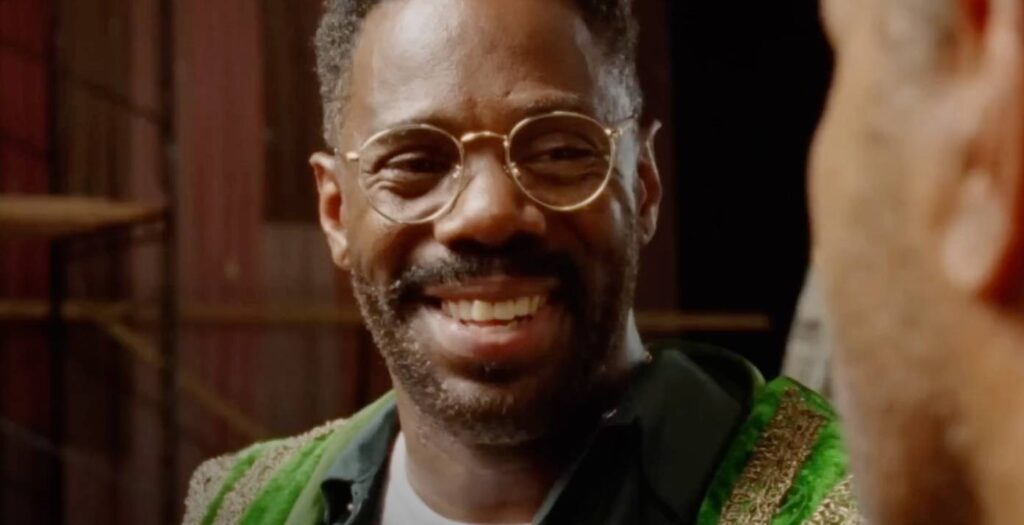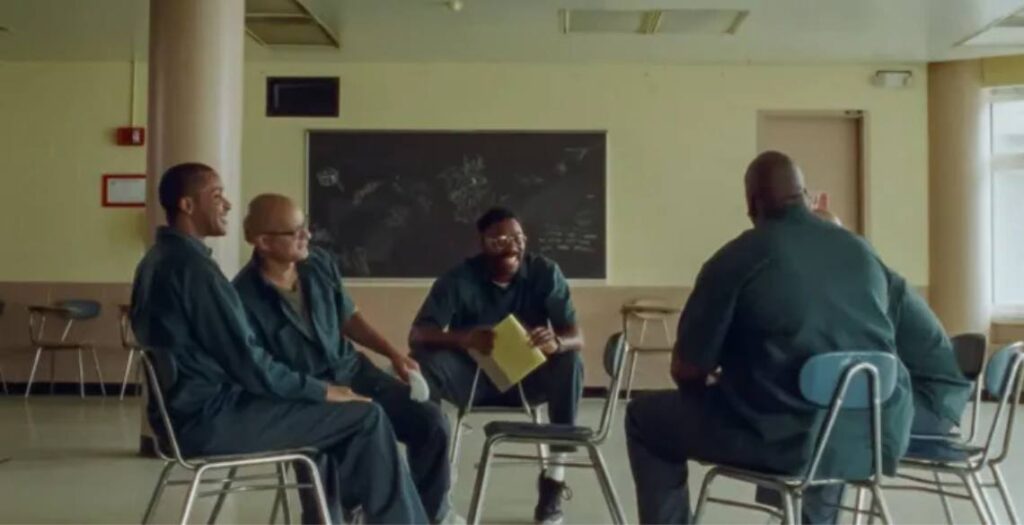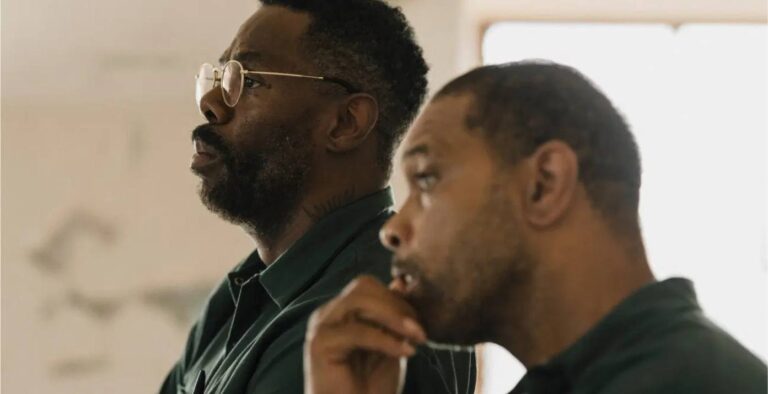When I saw Sing Sing at SXSW, I wept. But defining the tears I let out is difficult. Half of it was due to sad moments in the film, but the other half was due to the joy on display. To see men who are incarcerated through a lens of joy and hope is uncommon. To see them as people with passions and fears is something that Hollywood and the larger systems in the U.S. aren’t interested in doing. And above all else, to see Black and brown men cry, heal, laugh, and begin to find themselves in the arts is just as rare. Sing Sing captures all of that, and Writer-Director Greg Kwedar uses empathy to show it all.
We spoke with Kwedar and Producer Monique Walton about the film, its themes, and the important takeaway that they want audiences to walk out of the theater with. Sing Sing follows Colman Domingo as Divine G, a person incarcerated in New York’s Sing Sing prison.
But it’s not just about him. One of only two well-known actors in the film, the rest of the cast are all men who participated in Sing Sing’s Rehabilitation Through the Arts (RTA). The program aims to use acting and theater production to help the men in Sing Sing process their lives and offers a creative rehabilitation method. The film watches one cohort as they put on a production, open up to each other, and uplift each other as well. Based on John H. Richardson‘s book The Sing Sing Follies, the film’s screenplay is penned by Greg Kwedar and Clint Bentley.

First, we spoke with Greg Kwedar and Monique Walton about joy. We asked Kwedar and Walton about building a story of joy and hope while also considering how incarceration affects people and their families. Kwedar answered, “That’s a wonderful question. We were a vessel for what was happening. That joy existed and exists within the [RTA] program [at Sing Sing]. I think there is something sort of rebellious about the joy because it’s despite that hardship and that environment, it’s proof that it can exist anywhere and something that you can claim for yourself— and claim for your community. It’s very empowering to witness joy, I think. For anyone, but especially for anyone who finds themselves incarcerated and needing to cling to the kind of beautiful light that’s still within them.”
Walton added, “There’s radical love in this movie. And I think just like what Greg is saying, in terms of [joy] being something that we don’t see. You know, we have been bombarded with all these images of prison and what we think it’s like and what we think the people are like inside. I think it’s not a full depiction or reflection. One of the things we were trying to show is that there are people who are trying to help each other in prison, and there are spaces like [RTA], not everywhere, of course, but that this program was an example of ways that people are there for each other. That’s radical, you know? The system is built to dehumanize and to take away that access to connection and community.”
Witnessing Sing Sing is a form of that radical love that Walton describes. While some are playing versions of themselves, the men on screen aren’t shown to the audience as anyone other than actors. They are men who have unlocked a talent that not everyone has, and in doing so, they allow us into their hearts. We admire them on screen as we see their journeys, and as the tears flow in different scenes, we love them.
Kwedar expanded on the process of casting alumni from RTA, “For many [of the actors], what was really special about the process of making this film was that a lot of them have gone on to impactful lives on the outside since they’ve been home as community leaders, teachers, and doing a lot with at-risk teens. And so the invitation to come back to what they would call being ‘on the wood’ again was something undeniable, as well as to highlight a program that was so essential in their personal development and their community of family that was built inside. Many [of the alumni] jumped at the opportunity.”

The fact that the actors on screen had such deep connections to the story and to RTA wasn’t lost on Kwedar and his team. “I think our job as filmmakers was to design a process where everyone would have a moment to truly shine and bring forth all of that magic within them,” he said, “That was something we were very conscious of— creating moments where our alumni could have the floor. And once they had the floor, they knew what to do with that. They could all take the stage.”
Walton added, “It was just really powerful and exciting to know that [the men] would get to show their talents and shine. They’re all actors, you know? They all actually trained in the [RTA] program, and they all love the craft of acting. They were really building their own characters, even if they were based on themselves, [they were building a] version of themselves. It’s just exciting to play in that space and to give space for each of them to have a moment.”
For all of its emotion, Sing Sing hit me in a very personal way. I shared with Greg Kweda and Monique Walton that I have a cousin who is currently incarcerated. And, like some of the families in the film, ours have turned their back on him. As soon as my screening ended, my heart dropped, and I wanted to call my mom and talk with her about our family. The film works as a tool for communication for those of us who have our lives touched by incarceration and the prison system. It can help us shift our views, perhaps in an even more intimate way than those who haven’t been touched by the system.
Kweda responded to my story, “Thanks for sharing your personal connection to this, and I hope the film creates space for people to feel like they have the means to allow strangers into your story and the beauty of what that connection can unlock. Because the reality is that for families that have been touched by incarceration, the whole family is touched by it. The family is serving a sentence as well. The process of incarceration is a journey, and there’s a lot of feelings wrapped into that. I think [RTA] offers is a venue that you don’t have to hold those [feelings] to yourself, and that’s the real killer—everything we push down and don’t allow people who see us and care for us access to help walk through. We need each other.”
Walton added to Kweda’s point, “I echo that. I think film is an empathetic medium. It does build empathy and I think that its power is that it allows you to walk in someone else’s shoes and connect [with them].W e definitely heard that as a response as well from people who have been touched by incarceration that the film allows them to imagine what It’s like in a different way that feels more accessible. I think because it’s about humanity and it’s something that we can all connect to, it creates that avenue. And I think that’s what’s so it’s so powerful, and I hope that it’s, it continues to be used that way.”

To close out our talk, we had one question left: What do you want audiences to take away from the film?
Greg Kweda started, “I hope they feel a little more alive through the journey and the joy, vulnerability, and the tenderness that’s expressed on the screen. They’re witness to what can be awoken in men and harnessed by that person out in the world. I hope that [auduences] realize, and are now aware of, the human potential behind the walls [of Sing Sing]. And that they can’t unsee that and can’t ever retreat back to a place where they view a person who is incarcerated as a number. I hope people celebrate the friends in their lives and hold them closely.”
“I hope people feel their feelings and let those tears flow if they need to, Monique Walton said, “Let it out. It’s a dark room; no one can see you. I think that incarceration in this country is all around us. We incarcerate more of our population than any place else in the world. I think, in order to change that, [we need to] think about ways to be different. You have to imagine and use your imagination to think about how we can all collectively change that fact in the future. I do hope that audiences can sit with that and think about ways to really shift our mindset around incarceration.”
Sing Sing is playing in theaters nationwide now.







